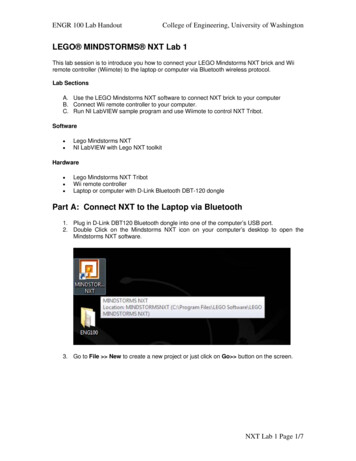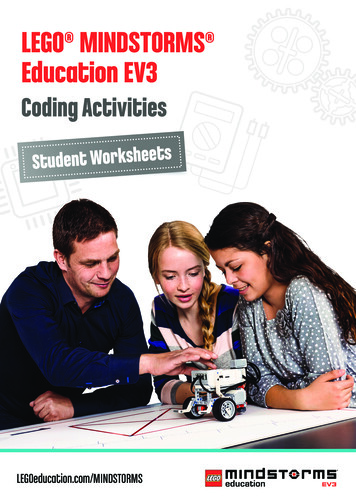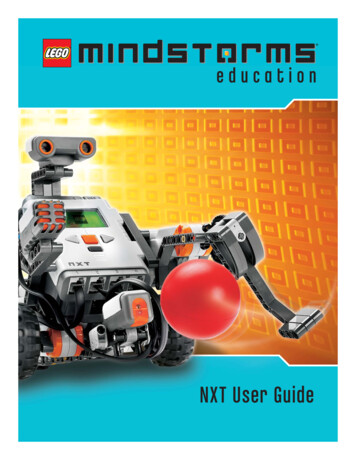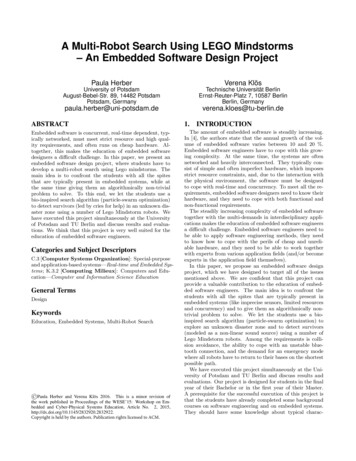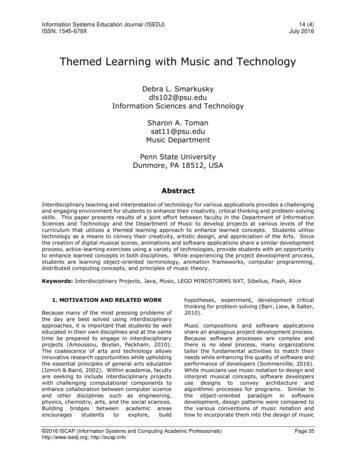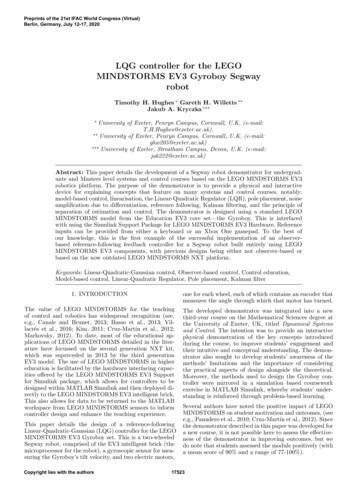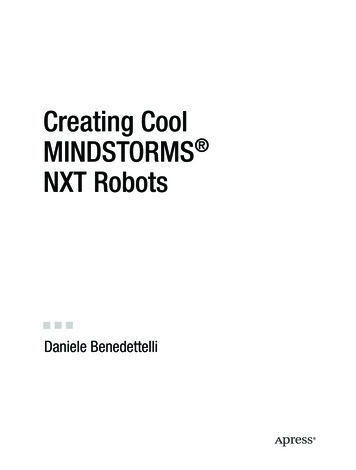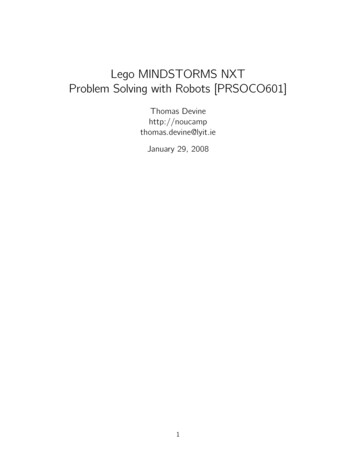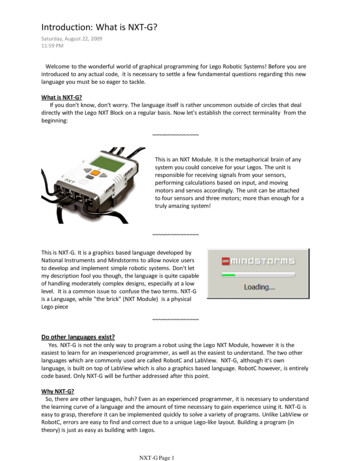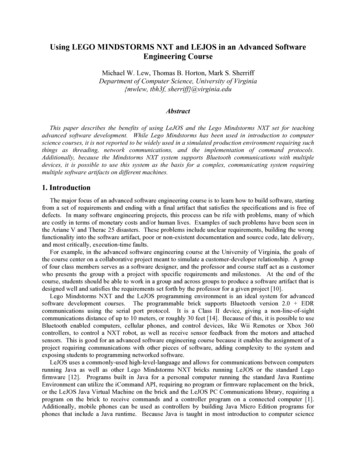
Transcription
Using LEGO MINDSTORMS NXT and LEJOS in an Advanced SoftwareEngineering CourseMichael W. Lew, Thomas B. Horton, Mark S. SherriffDepartment of Computer Science, University of Virginia{mwlew, tbh3f, sherriff}@virginia.eduAbstractThis paper describes the benefits of using LeJOS and the Lego Mindstorms NXT set for teachingadvanced software development. While Lego Mindstorms has been used in introduction to computerscience courses, it is not reported to be widely used in a simulated production environment requiring suchthings as threading, network communications, and the implementation of command protocols.Additionally, because the Mindstorms NXT system supports Bluetooth communications with multipledevices, it is possible to use this system as the basis for a complex, communicating system requiringmultiple software artifacts on different machines.1. IntroductionThe major focus of an advanced software engineering course is to learn how to build software, startingfrom a set of requirements and ending with a final artifact that satisfies the specifications and is free ofdefects. In many software engineering projects, this process can be rife with problems, many of whichare costly in terms of monetary costs and/or human lives. Examples of such problems have been seen inthe Ariane V and Therac 25 disasters. These problems include unclear requirements, building the wrongfunctionality into the software artifact, poor or non-existent documentation and source code, late delivery,and most critically, execution-time faults.For example, in the advanced software engineering course at the University of Virginia, the goals ofthe course center on a collaborative project meant to simulate a customer-developer relationship. A groupof four class members serves as a software designer, and the professor and course staff act as a customerwho presents the group with a project with specific requirements and milestones. At the end of thecourse, students should be able to work in a group and across groups to produce a software artifact that isdesigned well and satisfies the requirements set forth by the professor for a given project [10].Lego Mindstorms NXT and the LeJOS programming environment is an ideal system for advancedsoftware development courses. The programmable brick supports Bluetooth version 2.0 EDRcommunications using the serial port protocol. It is a Class II device, giving a non-line-of-sightcommunications distance of up to 10 meters, or roughly 30 feet [14]. Because of this, it is possible to useBluetooth enabled computers, cellular phones, and control devices, like Wii Remotes or Xbox 360controllers, to control a NXT robot, as well as receive sensor feedback from the motors and attachedsensors. This is good for an advanced software engineering course because it enables the assignment of aproject requiring communications with other pieces of software, adding complexity to the system andexposing students to programming networked software.LeJOS uses a commonly-used high-level-language and allows for communications between computersrunning Java as well as other Lego Mindstorms NXT bricks running LeJOS or the standard Legofirmware [12]. Programs built in Java for a personal computer running the standard Java RuntimeEnvironment can utilize the iCommand API, requiring no program or firmware replacement on the brick,or the LeJOS Java Virtual Machine on the brick and the LeJOS PC Communications library, requiring aprogram on the brick to receive commands and a controller program on a connected computer [1].Additionally, mobile phones can be used as controllers by building Java Micro Edition programs forphones that include a Java runtime. Because Java is taught in most introduction to computer science
courses, using a Java-based system imposes no learning curve for a new language, as well as allowing theuse of computers with the Java SE runtime and mobile phones running Java ME.2. BackgroundIn this section, we will discuss the use of robots in CS education and the Lego Mindstorms NXTsystem in general.2.1. Robots in CS EducationCommonly, robots are used in introduction to computer science courses. At the George WashingtonUniversity, the CS 001 introductory class exclusively uses Lego Mindstorms to teach problem solvingusing computers and applications of computer science to the real world [15]. Likewise, the introductorycomputer science course at Cansius College uses Lego Mindstorms and the LeJOS system [3]. To teachbasic computer science concepts such as control flow and the use of arrays, the United States Air ForceAcademy has studied using a previous version of Lego Mindstorms to teach an introductory course usingAda [6]. At some colleges, the visual programming language used in the Lego-supplied software to teachthe concepts of computer science without making students who may be unfamiliar with a programminglanguage to learn the syntax of a high-level language like C or Java, two of the languages that arecommonly used in introductory computer science courses [4].Robots have also been used in single-topic computer science courses. One of the areas that robots aremost often used for pedagogical purposes is the field of artificial intelligence. At Williams College,robots are used to introduce students who may not be computer science majors to the concepts of artificialintelligence and behavioral programming through the use of robotic vehicles and a high-level language[5]. The City University of New York, Staten Island, also uses robots to teach artificial intelligence, butthe course is tailored for third and fourth year computer science majors and requires a proficiency in C [7]. At the University of Salzburg, robots are used to teach embedded software engineering, coveringreal-time operating systems and communications protocols, scheduling, real-time programming, and codegeneration [8]. Villanova University has used Mindstorms robots to teach computer organization andoperating systems concepts [9].A common feature in both the introductory courses and the single-topic courses is that none of themrequire students to design a software artifact from a specification using software engineering practices. Inthe introductory courses, both for computer science majors and non-computer science majors, the projectsare rather simple, like programming a robot to follow a line by using a light sensor, or pushing cans out ofa dark area of a board [2, 4]. While it is common for groups to be formed in introductory classes that userobots, the projects do not require, nor do introductory classes teach, software engineering concepts likespecifications elucidation, design practices, or verification. Additionally, these classes do not attemptcollaboration between groups. In the advanced, single-topic courses, the focus of the course is on aparticular concept, and while it requires the use of sound software engineering practices, the course treatsknowledge of such practices as a prerequisite [8].2.2. Lego Mindstorm NXT SystemAn educational version of the Lego Mindstorms NXT system is available through Lego Education. Itcontains a programmable brick, three motors, one light sensor, one ultrasonic (sonar) sensor, one soundsensor, and two touch sensors. The programmable brick contains three output ports used to power themotors, and four input ports used to connect sensors. Legacy support is included via converter wires thatconnect to the NXT programmable brick and legacy 9V motors and Robotics Invention System sensors.Optional additions to the kit include aftermarket sensors from Mindsensors or HiTechnic, which includevision systems, infrared detectors, color sensors, and compass units, among others [1].
The Mindstorms NXT brick uses a 32-bit ARM processor as its main processor, with 256 kilobytes offlash memory available for program storage and 64 kilobytes of RAM for data storage during programexecution. To acquire data from the input sensors, another processor is included that has 4 kilobytes offlash memory and 512 bytes of RAM. Bluetooth Class II V2.0 communications are included for wirelessconnectivity, and a brick can be connected to a USB port on a computer. The motors included in the kithave built-in rotation sensors accurate to /- 1 degree, and two motors can be synchronized as a driveunit. To give the robot the ability to “see,” the ultrasonic sensor, which is accurate to 3 centimeters andcan measure up to 255 centimeters, and the light sensor, which can distinguish between light and dark,can be attached to the brick. A sound sensor that can be adjusted to the sensitivity of the human ear canbe used to give the robot the ability to hear and react, if programmed, to noises. Finally, the two touchsensors give the ability for a robot to determine if it has been pressed, released, or bumped, and reactaccordingly [1].As a replacement for the standard Lego firmware, the LeJOS project has adapted the TinyVM JavaVirtual Machine from the original Mindstorms RCX brick to the new, more powerful NXT brick. It hassupport for threading, arrays, recursion, synchronization, exceptions, non-generic data structures, standarddata types, and input and output [13]. The LeJOS virtual machine supports much of the java.util package,but the data structures require that data be stored as type Object and then cast to a type that inheritsObject. For input and output, both streams and sockets are available for use. Streams in the java.iopackage can be used across a Bluetooth serial port connection and require an input and output stream onboth the brick and connected device. For control purposes, the LeJOS platform supports the directconnection of Bluetooth-enabled GPS units for spatial location information and keyboards for thenavigational control of a robot [12].3. LeJOS/Mindstorm Project at UVaIn Spring 2009, we used LeJOS and Mindstorms for the first time in our Advanced SoftwareDevelopment course. The semester was split into two projects, called the Minor Project and the MajorProject. The Minor Project was intentionally better specified and somewhat easier than the Major Projectso that students could first gain an understanding of programming for the Mindstorm system before werequired them to do more requirements and design documentation. Another reason we feel that focusingon the technology earlier was better was that they gained an appreciation for the benefits of properdocumentation as some parts of their assignment went smoother at the end of the semester.Both projects revolved around a story about a mission to Mars. During the mission, the escape pod ofthe spacecraft crashed into a crater. The Minor Project had students building a robot with a winch thatcould lift the escape pod out of the crater. The robot itself had to be controlled with the accelerometer ona Wii Remote. After the rescue mission, the student teams were informed that the crashed astronauts haduncovered an alien civilization and they had to build a robot that could explore the area autonomously.Further, two teams would have to build their robots such that they could communicate with each otherand help direct the other robot. The first task was for one robot to navigate a maze and then send thedirections to the other robot. Then the robots had to use a sound sensor to hone in on a distress beacon.Finally, the robots had to be driven to their final destination. Example pictures of the tasks are shown inFigure 1.
Figure 1. A robot searching for the escape pod and a robot navigating a maze autonomouslyThe components of the Major and Minor project encompassed numerous technological challenges.Students had to learn Bluetooth for robot and Wii Remote communication. The Wii Remote’saccelerometer had to be tied into the system for navigation. AI concepts had to be employed so that therobots could autonomously navigate a maze. The two robots communicated through the host computersover the school’s wireless network.4. Pedagogical GoalsThe goals of the advanced software engineering course at the University of Virginia are to introducestudents to the practice of software engineering with a simulation of a real-world situation. Specifically,our course goals are for students to:1.2.3.4.5.Develop an understanding of how to specify, design, and implement a complex software entity thatinvolves many aspects of modern software systems.Master a number of modern tools and a number of difficult technical fields including user interface design,distributed architecture development, and concurrent programming.Develop the skills necessary to prepare professional quality technical documents as are required in thecreation of complex software systems.Develop the presentation skills necessary to convey elaborate and detailed technical concepts to colleagues.Acquire experience of working on a large software system as a member of a group working on systemdevelopment and as a member of a group that has to interact with other groups and customerrepresentatives.In general, students are broken up into groups of four to five members, and each group acts as acompany. The groups receive a project specification from the course staff, and they have certainmilestones that must be met throughout the development timetable. Additionally, a small portion of thecourse is dedicated to teaching students about the different methods used in software development.For the Mindstorm projects, we used the Minor and the Major projects to address different aspects ofthese goals. The Minor project was focused on goals 1 and 2. During the Minor project, which took thefirst month of class, we did not focus on documentation to any great degree. We did this intentionally togive students a greater opportunity to experiment with the programming tools and technology and tobecome more familiar with what they could do with it. The students did, however, have to provide basicarchitecture sketches for their systems.Concurrently, the course lecture sessions focused on teaching students the methods of softwaredevelopment, emphasizing the steps that should be followed for good software to be developed. As wemoved into the Major project in the second half of the course, students were more comfortable with thetechnology and we began having them write more complete requirements and design documents and give
presentations on their development efforts to their classmates. Further, as teams were forced to worktogether to build a combined system, the need for thorough documentation became more apparent for thestudents. Software requirements specification documents were swapped between partner groups so as tosimulate receiving requirements from a customer for which software must be built.The last phase of the course focuses on verification of the software artifacts to ensure that the rightfunctionality was built into the software and that the software works. To validate that the correctfunctionality was built into the software, groups had to consult the software requirements issued by thecustomer earlier in the course and verify that each requirement was satisfied. Verification of correctfunctionality can be done through testing the software artifacts. The system is built correctly if it cancomplete the trial run within the parameters of the software specifications, and it is easily visible that asystem is correct or incorrect based off of the actions taken when, or if, the robot is under autonomouscontrol.5. EvaluationThe use of Lego Mindstorms and the LeJOS for advanced software development is intended tointroduce students to building complex systems utilizing communications and threading. A studentsurvey was done to determine the usefulness of Lego Mindstorms and LeJOS for teaching threading,communications and communications protocols, and building complex systems bringing the concepts ofthreading and communications together. Specifically, respondents were asked to rate the usefulness ofthe Lego Mindstorms and LeJOS systems for teaching said concepts on a scale of 1-5. Thirty-nineresponses were received, the results of which are summarized in Table 1 below.Table 1. Results of student survey.QuestionAveragescore(1) Was the major project [a complex project similar to that described3.92above] an interesting or motivating project? (1 not motivating; 5 very motivating)(2) Usefulness of the Lego Mindstorms NXT and LeJOS systems in3.52learning how to build threaded software (1 not useful; 5 very useful)(3) Usefulness of the Lego Mindstorms NXT and LeJOS systems in3.53learning how to plan and implement custom communications protocols(4) Usefulness of the Lego Mindstorms NXT and LeJOS systems in3.71learning how to build a complex system involving threading andcommunications between multiple devicesPct. of positiveresponses77616371Students were also asked about problems encountered in implementing communications protocols withLeJOS. Many of the problems centered on Bluetooth communications, with students finding that it waseasy to overload the brick, that the Bluetooth connection could be unpredictable, and that LeJOS does notsupport the full functionality of the String type or sending Strings over a Bluetooth connection.Based on the student response, it would seem that, overall, using Lego Mindstorms and LeJOS to teachadvanced software engineering was somewhat useful. On Question 1, 77 percent of respondents believedthat the major project was a somewhat or very motivating project. Regarding the usefulness of the LegoMindstorms system and LeJOS in learning how to build threaded software, Question 2 of the survey, 61percent of respondents who implemented threading indicated that the systems used were somewhat orvery useful in learning the concept. The response to Question 3, the usefulness of the system in learningabout communications and communications protocols, indicated that 63 percent of respondents viewedthe Lego Mindstorms system and LeJOS as a somewhat or very useful tool for learning said concept.Finally, 71 percent of respondents believed that the Lego Mindstorms and LeJOS systems were asomewhat or very useful platform for learning about building complex systems involving threading and
communications between multiple devices. Overall, based on the average of the responses, studentsbelieved that the Lego Mindstorms and LeJOS systems were somewhat useful in learning about softwaredevelopment.Judging from course evaluations, it seems that a number of students were frustrated with the Bluetoothlibraries used to communicate between devices like the Wii Remote and the NXT brick, as well as withproblems getting their Bluetooth dongle to work with the Wii Remote, NXT brick, or both. Also, somestudents felt that working with Lego Mindstorms presented frustrations with compatibility problems withvarious computers and was too hardware-focused for a software engineering course. It is likely that thestudents who experienced the most problems with the hardware used for the project also did not think thatthe project was useful for achieving the goals of an advanced software development course.The instructor of the course (the third author of this paper) was also asked to rate the effectiveness ofthe Lego Mindstorms system and LeJOS for teaching advanced software development. The LegoMindstorms system was rated as neutral on teaching threading, somewhat useful on teachingcommunications and communications protocols, and somewhat useful in teaching software engineeringtechniques. Overall, Lego Mindstorms and LeJOS was rated as a good system for teaching advancedsoftware development, despite the fact that the code base was too small for certain software engineeringaspects, like subversion and code analysis, to be as useful as it could have been. From a technicalstandpoint, difficulty with Bluetooth communications was singled out as a particular problem.6. Other Possible Assignments and Projects Using LeJOSWe have discussed in detail how we made use of Mindstorms and LeJOS in our course’s project. Butthere are many possible ways software engineering instructors could incorporate this robot environmentinto their courses. In this section, we outline a number of possible assignments and projects.LeJOS supports both Bluetooth wireless communications through the serial port protocol as well ascommunications over a USB connection. In the minor assignment addressing communications, it is notrequired that threading be implemented, as this is designed to be an overview to the process by which acomputer or other remote device connects to an NXT brick, sends data, and receives data. Regardless ofwhether Bluetooth or USB is used to connect to an NXT brick, the connection will implement aDataInputStream and a DataOutputStream generated when a connection is opened between an NXT brickand a remote device.A simple communications project is included in the LeJOS distribution in the [installationpath]\samples\ directory. It consists of two projects – BTSend, which runs on a PC and establishes aconnection with an NXT brick, and BTReceive, which runs on an NXT brick and waits for a connectionto be made from a remote device. The PC sends an integer to the NXT brick, which negates that integerand sends it back. This project does not require threading because the data input stream is not required towait a long time for data to be flushed through the data output stream. Concurrent communications is notimplemented in this; however, a variation on this may be made to implement threaded communications sothat both the PC and NXT brick send and receive integers simultaneously. This would require threadingso that both the PC and NXT brick receive data without having to wait for a response from the oppositeside of the connection.Another project that may be assigned is the creation of a communications protocol that defines howcommands are sent to an NXT brick and how data is sent from an NXT brick. Because thecommunications protocol is undefined if iCommand is not allowed to be used, the implementation of acommand protocol is a necessity for a major project involving communications between a PC and NXTbrick. Using the framework of a thread for input and a thread for output, a command interpreter can beimplemented on the NXT brick in the input thread, and periodic data output by requesting data fromattached sensors can be implemented in the output thread. This project may be assigned as a collaborativeeffort between two partner teams, where both teams specify a communications protocol, one teamimplements the NXT brick side of the system, and the other team implements the PC side of the system.The NXT side of this system would implement a command interpreter and data sender, and the PC side of
the system would implement a data listener and a command sender. To emphasize good softwareengineering practices, a communications protocol requirements document should be required such thatthe two teams involved in creating and implementing a communications protocol have firmdocumentation to consult during development, avoiding conflicts from the wrong commands beingimplemented in either the interpreter or the command sender.Because of the limitations of the LeJOS virtual machine in supporting some basic Java methods, suchmethods as String.split, groups are forced to find alternative methods to accomplish their goal, as canhappen in industrial projects. In this particular example, teams could either devise their own stringsplitting method to handle textual commands or create a numerical command protocol that can be sentusing the methods supplied by the DataOutputStream object. Additionally, groups will have to be carefulabout the amount of data sent to and from the robot over the Bluetooth serial connection, as a highamount of traffic will slow down the reaction time to commands appreciably. While this can bemitigated, to some extent, by the use of threading, a high amount of traffic will cause commands to bebuffered in the DataInputStream object, and recently sent commands will not be executed in a timelyfashion.In the scope of a major project involving threaded communications, these projects give each group theknowledge necessary to implement communications in a larger project, both for concurrent input andoutput as well as sequential input and output. Creating a command interpreter and command protocol isgreatly beneficial for the development of the final software artifacts to be developed for the course.Because portions of prior software are reused in newer software, this offers an opportunity for theprofessor and course staff to teach the proper methods to reuse portions of software artifacts and avoiddisasters, like the Ariane V explosion, that result from improper reuse of software artifacts or portionsthereof.Designing and implementing a complex and/or a collaborating system is a task that is a major focus inmany advanced software engineering course. For this, robots are ideal because the design andimplementation of a complex and collaborating system requires software to be designed to be able to do aseries of tasks, not necessarily controlled from a connected device, and send data to a connected devicethat can be utilized by multiple robots. As noted above, LeJOS can be used to implement such a systemthrough its communications capabilities, ability to program autonomous behavior into a program, and useof Java. Control need not be limited to simple mouse clicks or button presses on a keyboard; Javalibraries exist for the use of other control devices connected to a PC.An additional layer of complexity may be added with the use of the Wii remote as a control device,rather than using a keyboard’s arrow keys or a mouse-based interface to control the robot. Instead ofusing the arrow pad as the primary means of control, the accelerometers used in the Wii remote may bespecified as the input from which the robots will run on. By using the Wii remote, students learn how tobuild software that integrates multiple unfamiliar libraries – the LeJOS and WiiRemoteJ libraries – in aseamless fashion. If use of the accelerometer feature is added as a requirement, it introduces the problemof interpreting data and sending a command, or series of commands, based on that data.7. ConclusionBecause LeJOS supports networked communications and threading, as well as the fact that a PC-sideJava program can be extended to support additional control devices, integrated databases, and otherfeatures, it is an ideal platform from which Advanced Software Engineering courses can be taught.Simple projects may be assigned at the beginning to introduce students to the limitations and features ofLeJOS and the Lego Mindstorms NXT system. From those simpler projects, students should be able tocomplete a complex project such as the ones described above with the appropriate documentation and aset of software artifacts with the correct features implemented and verified to work correctly.Instructors that consider a software engineering course centered on the use of Lego Mindstorms shouldensure that enough time and resources are set aside for the upkeep and maintenance of the Lego kits andfor technological issues that might arise. Significant time was spent in answering Bluetooth connectivity
questions, which led to some frustration from the students. The difficulties were an opportunity forstudents to see how technological issues can arise in systems, but the frustration did detract some from thelearning experience. Overall, though, there are sufficient technical challenges with the use of LegoMindstorms that they will continue to be used in this course in future semesters.8. References[1] Bagnall, Brian. Maximum Lego NXT. Winnipeg, Manitoba: Variant Press, 2007.[2] Burhans, D. 2007. A robotics introduction to computer science. Paper presented at the AAAI spring symposium, March 2628, in Stanford, California, USA.[3] Burhans, D., Meyer, R., VanVerth, P., Puehn, D., Steck, V., & Wiejaczka, J. 2006. Introductory computer science withrobots. Paper presented at the proceedings of the 21st National Conference on Artificial Intelligence, July 16-20, in Boston,Massachusetts, USA.[4] Cliburn, D. 2006. Experiences with the Lego MindstormsTM through the undergraduate computer science curriculum. Paperpresented at the 36th ASEE/IEEE Frontiers in Education conference, October 28-31, 2006, in San Diego, California, USA.[5] Danyluk, A. 2004. Using robotics to motivate learning in an AI course for non-majors. Paper presented at the AAAI springsymposium, March 22-24, in Stanford, California, USA.[6] Fagin, B., Merkle, L., & Eggers, T. 2001. Teaching computer science with robotics using Ada/Mindstorms 2.0. Paperpresented at the proceedings of the 2001 annual ACM SIGAda international conference on Ada, September 30-October 3, inBloomington, Minnesota, USA.[7] Imberman, S. 2003. Teaching neural networks using Lego-Handyboard robots in an artificial intelligence course. Paperpresented at the proceedings of the 34th SIGCSE technical symposium on computer science education, February 19-23, in Reno,Nevada, USA.[8] Kirsch, K. Embedded software engineering course. University of Salzburg. http://cs.unisalzburg.at/ ck/teaching/EECS290O-Spring-2002[9] Klassner, F., & Continanza, C. 2007. Mindstorms without robotics: an alternative to simulations in systems courses. Paperpresented at the proceedings of the 38th SIGCSE Technical Symposium on Computer Science Education, March 7-1-, inCovington, KY, USA.[10] Knight, J., & Horton, T. 2005. Evaluating a software engineering project course model based on studio presentations. Paperpresented at the proceedings of the 35th ASEE/IEEE Frontiers in Education Conference, October 19-22, 2005, in Indianapolis,IN, USA.[11] The Lego Group. 2006. Lego Mindstorms NXT Bluetooth Developer RMS%20NXT%20Bluetooth%20Developer%20Kit 58CE458E-5292
2.2. Lego Mindstorm NXT System An educational version of the Lego Mindstorms NXT system is available through Lego Education. It contains a programmable brick, three motors, one light sensor, one ultrasonic (sonar) sensor, one sound sensor, and two touch sensors. The programmable brick contains three output ports used to power the
